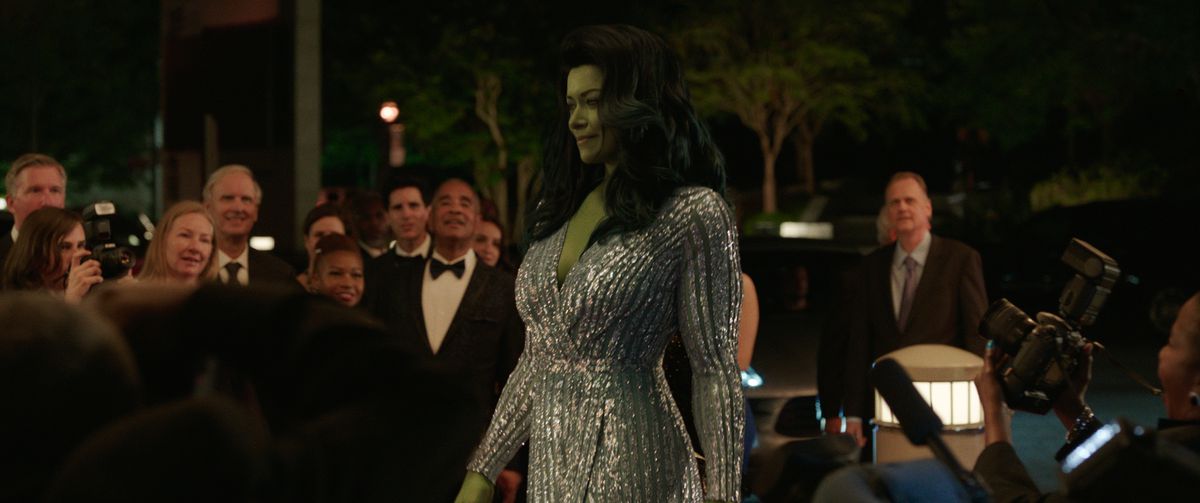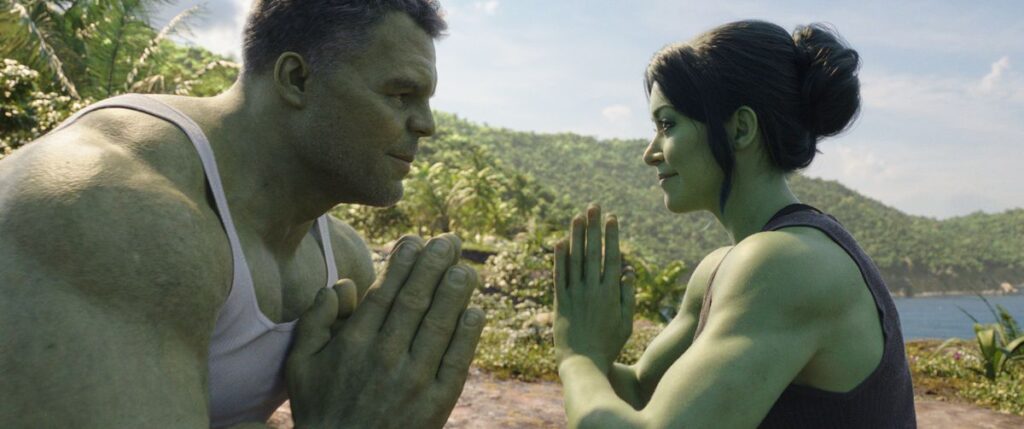She-Hulk: Attorney at Law makes its thesis statement about 13 minutes into its first episode: When Bruce Banner (Mark Ruffalo) tells his cousin — newly Hulked, thanks to an accident — Jen Walters (Tatiana Maslany) that the triggers are anger and fear, she scoffs. “Those are like the baseline of any woman just existing.” It’s a point she’ll hit harder later in the episode, after weeks of training to be dexterous and zen so as to not accidentally Hulk out. As he reminds her that the most important thing in the whole world is for her to not get scared or, more importantly, angry, she hits him with the manifesto, of sorts, for She-Hulk:
“Here’s the thing, Bruce: I’m great at controlling my anger. I do it all the time,” Jen says. “When I’m catcalled in the street, when incompetent men explain my own area of expertise to me — I do it pretty much every day because if I don’t I will get called ‘emotional’ or ‘difficult’ or I might just literally get murdered. So I’m an expert in controlling my anger because I do it infinitely more than you.”
To demonstrate how fully in control she is, she briefly morphs into She-Hulk. Eventually, we’ll see her prove herself right, returning to the regular world and suffering her misogynistic co-worker’s snide comments with aplomb. It’s all a great win for feminism.
The question is: How far will — can — She-Hulk go with this limited brand of feminism?
Image: Marvel Studios
There’s a lot of Feminism 101 shows out in the world already — your Bold Type or Supergirl. Per the four episodes provided to critics for review, She-Hulk fits in with those shows without much challenge; feminism and the people it covers isn’t one-size-fits-all, and these shows are more of a foundation to inspire younger folks who are just beginning to find what kind of feminist action they want (or need) in their life. In its initial episodes, She-Hulk isn’t revolutionary, and for a certain set of viewers that’s OK. That the show is able to address the undercurrent of anger that comes with feminism is a step toward acknowledging rage as merely a valid response to a world that is broadly inhumane, in ways big and small, to women every day.
It’s a double-edged sword that the creators behind She-Hulk know too well. The show centers Jen’s discomfort with heroics as part and parcel with her uneasiness around how people treat her new looks. As She-Hulk she’s respected, defended, applauded — even just seen more.
“In terms of the CGI being critiqued, I do think that has to do with our culture’s belief in their ownership of women’s bodies. I think a lot of the critique comes from feeling like they’re able to tear apart the CGI women,” She-Hulk director Kat Coiro said during the Television Critics Association panel on the show. “There’s a lot of talk about her body type. And we based her a lot on Olympian athletes, not bodybuilders, but I think if we’d gone the other way we would be facing the same critique. I think it’s very hard to win when you make women’s bodies.”

Image: Marvel Studios
Even in the first episode, She-Hulk feels clear about how this transition is layered by Jen being a woman. But still, it’s frustrating to see a movement be filtered through Marvel Studios, whose general ethos is like if King Midas sanitized everything he touched. There’s no way the (modern) MCU wants to get as thorny and provocative as feminism actually is in the real world; feminism is a political ideology (no matter what slogan T-shirts tell you!), which means that some topics will inherently feel taboo, prickly, and disruptive. You will not get things like that in a Marvel Studios project, by design. And so a lot of the feminism of She-Hulk feels a little too pat — of course the sexist co-worker’s slights are things like “more smiles,” and the bad bros she runs into just a little too clear about how much her femininity is what irks them.
Because here’s the thing about She-Hulk: There are all kinds of Olympians. They’re bodybuilders, swimmers, runners, rowers, skiers, gymnasts, and more. They’re bulky just as often as they are slim. And so when Cairo tells Polygon that the body type they settled on was akin to Misty Copeland, someone who is “strong and powerful, but […] can go to a restaurant and have a date, can work in a regular office and sit in a regular office chair,” it feels like just more Marvel sheen, where edges get sanded off to make for a common denominator. She-Hulk’s muscles have looked different through several decades of comics, and it’s telling that She-Hulk’s iterations fall in line with a more conventionally attractive body type. For all She-Hulk feints at being “feminist TV,” it’s still bound up in a specific conception of womanhood and empowerment. The show can only conceive of its heroine as a feminine answer to Hulk, so it can’t fully imagine what it would mean to be free of a comparison at all.

